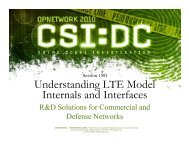Automated Axon Tracking of 3D Confocal Laser Scanning ...
Automated Axon Tracking of 3D Confocal Laser Scanning ...
Automated Axon Tracking of 3D Confocal Laser Scanning ...
You also want an ePaper? Increase the reach of your titles
YUMPU automatically turns print PDFs into web optimized ePapers that Google loves.
After the region <strong>of</strong> interest is identified, the threshold for guided region growing algorithm inthe first iteration is set to one level higher than the lowest intensity pixel in the region <strong>of</strong> interest.All the pixels in the image that are lesser than this threshold are considered to be submerged inwater in the current iteration. A list <strong>of</strong> unlabeled pixels is maintained for all the pixels that aresubmerged so far. For each <strong>of</strong> the regions in the image, connected components are searched fromthis list. From the list <strong>of</strong> pixels in the connected component list, individual pixels are added tothe region and the likelihood <strong>of</strong> occurrence <strong>of</strong> the new region is computed. The pixels areretained only if there is an increase in the likelihood. The same process is repeated until thethreshold reaches to the maximum value <strong>of</strong> the pixel in the region <strong>of</strong> interest. Since these pixelsare not reordered to find alternate paths for region growing, the algorithm introduced here is agreedy one. In Figure 9(d)-(e), we compare the segmentation results <strong>of</strong> the seeded watershedalgorithm and the guided region growing algorithm.(a)(b) (c)(d) (e)Figure 9 - Segmentation <strong>of</strong> axons using guided region growing: (a) Original image with seeds found usingmean-shift, (b) Seed regions, (c) Boundaries using seeded watershed algorithm with seed regions, (d) Magnifiedversion <strong>of</strong> boundaries in (c), and (e) Boundaries detected with guided region growing. Scale bars in the figurescorrespond to 2μm.It should be noted that the accurate segmentation <strong>of</strong> the faint and the small axons is crucial inpreventing the propagation <strong>of</strong> errors in tracking to the next slice. Such errors can adverselyimpact the quantitative analyses <strong>of</strong> the underlying biological questions.22















